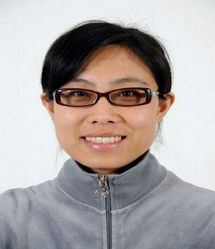Multiscale Simulations of Star Polymer Melts
Promotion date: June 20.
Promotor: Prof.dr. Wim Briels
Assistant Promotor: Dr.ir. Wouter den Otter
| Depending on the architecture, polymers are observed to show different dynamical and rheological properties. The aim of this work was to reveal how architecture affects polymer behavior. The results obtained will not only contribute to a fundamental understanding of the character of star polymeric systems, but may also help to design industrial architecturally complex polymer materials with specific macroscopic properties. Simulations are carried out with a coarse grained method at multiple levels: Molecular Dynamics (MD) simulations at atomistic level; the mesoscale Twentanglement model, where each polymer is represented by a chain of consecutive soft blobs; and highly coarse grained Responsive Particle Dynamics (RaPiD) simulations, in which a polymer is reduced to a single particle. The dynamics and visco-elastic properties of symmetric and asymmetric three-armed star polymers with various arm lengths are studied. The comparisons between stars and matching linear polymers are implemented to highlight the effect of polymer architecture on the bulk behavior. The scaling law of the star viscosity with molecular weight and branch point motion are also investigated. Also a method is presented to calculate all functions and parameters in the responsive particle model from an underlying small scale simulation, which proves that a many-body model is capable of describing the system dynamics very well. |
Was your research fundamental in nature?
The dynamics of architecturally complex polymers are studied within a European project in which ten universities and two industrial partners are involved. Here I focused on simulation studies of branch polymers. The physical properties of polymers are strongly correlated to their underling architecture. Depending on the density and degree of branching, they can be used to manufacture many products in industry. To be able to fabricate reasonable products from them, more fundamental understanding is required. My research was aimed at that. From here well-aimed experiments can be set up. The results may lead to designing tools to produce new products in the longer term.
Was working on this project a new experience to you?
Beforehand I knew that the PhD project was part of this European project, as I checked this online and contacted my supervisor Professor Wim Briels on this. It was clear to me that polymer physics would be quite new to me, and that I had to work on that, to learn more about diffusion processes, the dynamics involved and the rheology part. My supervisor assured me I would be given enough time and support to find my way into these new concepts and scientific knowledge areas.
One of the first events of the PhD work was a workshop at a plant of Dow Chemicals. Here I received a limited first training in polymer physics, and I could form a clear image of the various partners involved in the project. Some first contacts and collaborations started from there, making it possible for me to find my way into the project.
Can you recall some special moment during your PhD period?
In the beginning of my PhD work a lot of new things were happening. In trying to extend the simulation tools towards dealing with more ´branched´ polymers - which could get entangled as well – was a major challenge, right from the start. It took a lot of time and effort to try and crack this problem. I remember one Sunday morning when I realized that the time to come up with this tool was limited, and from then on I worked on it frantically: programming, adjusting the simulation models, running them and finally submitting the results. It took some weeks. When the results were positive and the article was submitted my supervisor and I were very happy. I remember I opened a bottle of red wine to celebrate the occasion.
In what journal was your article published?
This one was published in the Journal of Chemical Physics. Herein, another one is submitted as well as in the Journal of Soft Matter. One article is still under preparation.
What are your future plans?
I would like to stay in academics regarding my future job. Before starting in Twente, I had a job in industry, so I am able now to compare the two worlds. In industry the work is very product oriented. In academics one is able to learn more, and I like the open atmosphere better. Comparing myself now and four years ago, I possess many more skills to deal effectively with problems arising during complex research projects like these. This will help me finding a nice position in China, I am sure of. I would like to develop my skills further in a new direction of research.
What, in your opinion, is important for Mesa+ to stay successful in future?
I liked to collaborate with colleagues from other groups. In this project, for example, I collaborated with simulation experts from Spain who were specialized in macro sized aspects of this kind of polymer research. Also, I had close contact to simulation experts here at Mesa+. Having an office next to the NanoLab, I met a lot of Mesa+ researchers. It is a great feeling to share so many similar project experiences with talented people nearby.
It would be great if the simulation models and results could be taken further by performing experiments on them within Mesa+, and discuss the results straightaway preferable even at lunchtime. This will be wishful thinking I am afraid, as the Computational Biophysics Group is under some pressure at the moment. It would be a great loss if this Group should disappear from the Mesa+ research agenda.

